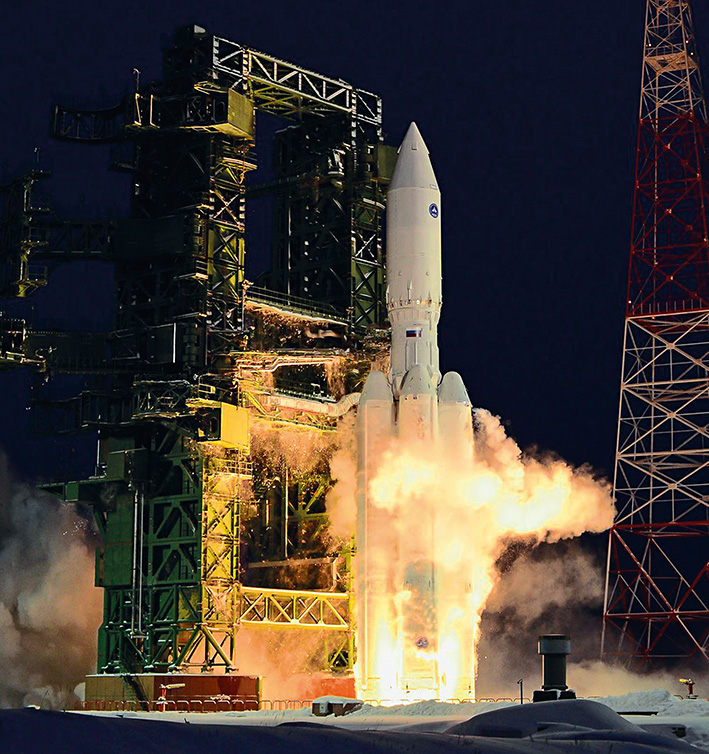|
 2014 proved to be rich in epoch-making events in space exploration all over the globe. India launched a prototype of its manned spacecraft onboard the latest GSLV MkIII rocket. The European Space Agency landed the Filae probe onto the Churimov-Gerasimenko comet. The United States started the flight tests of the MPCV Orion multirole spacecraft. Russia kicked off flight development tests of the new-generation Angara launch vehicle. It would not be an overstatement to say that the event of the year to Russian spacecraft and launch vehicle developers was the maiden flight of the Angara-A5 heavy-lift LV from the Plesetsk space launch centre on 23 December 2014. 2014 proved to be rich in epoch-making events in space exploration all over the globe. India launched a prototype of its manned spacecraft onboard the latest GSLV MkIII rocket. The European Space Agency landed the Filae probe onto the Churimov-Gerasimenko comet. The United States started the flight tests of the MPCV Orion multirole spacecraft. Russia kicked off flight development tests of the new-generation Angara launch vehicle. It would not be an overstatement to say that the event of the year to Russian spacecraft and launch vehicle developers was the maiden flight of the Angara-A5 heavy-lift LV from the Plesetsk space launch centre on 23 December 2014.
Actually, it is the heavy-lift Angara that the programme was launched for over 20 years ago. Russia needed independent access to outer space, which, simply put, means the ability to launch any spacecraft, including geostationary ones, from the Russian territory.
The flight development tests were aimed mostly at testing the systems and dynamics of the LV and systems of the versatile launch complex in the course of launching a heavyweight rocket. To attain the targets, a demonstration flight was conducted, which inserted a 2,042-kg satellite soft mock-up into geostationary orbit.
Two trains carrying units and compartments of an Angara-A5 heavy-lift rocket came to Plesetsk on 25 July 2014. It was reported as far back as 2013 that the Angara-A5’s first launch would take place in late 2014. For a while, the launch was planned for 25 December, but it was shifted for an earlier date, 23 December.
On 10 November, the heavy rocket was brought to the versatile launch complex for the first time for electrical tests and launch equipment checkout. These were completed on 26 November, having proven the complex’s preparedness for launching a heavy-lift rocket.
A week before the launch date, the fuel tanks of the Breeze-M upper stage, inherited together with the nose fairing from the Proton-M LV, were fuelled.
The rocket was taken to the launch complex on 20 December. At noon, it was placed into the launcher, set upright and connected to the electrical, pneumatic and hydraulic systems. On the next day, there were various tests as well as a dry run of the launch readiness of the control system. Telemetry was processed and analysed.
On 22 December, a session of the State Commission gave a nod to the fuelling of the rocket. The countdown commenced 11.5 h and the fuelling 4 h prior to the launch. Everything went with a swing.
At the estimated time, the ignition command was issued for the five engines of the lower stages, and the Angara-5A lifted off the launching pad at 8 h 57 min Moscow time. The launch weight of the carrier rocket accounted for 763.6 t and the weight of the upper stage, nose faring and soft mock-up stood at almost 25.8 t.
Having performed the collision and contamination avoidance manoeuvre, the rocket had climbed vertically and then began to execute the programmed pitch angle. 12 minutes after the blastoff, the upper stage assumed an open suborbital trajectory. The datum orbit was achieved by means of the Breeze-M. Afterwards, it would make three more burns, reaching geostationary orbit with an altitude of 35,793 m nine hours after the launch. The flight programme did not provide for separation of the soft mock-up. Having spent about an hour and a half in geostationary orbit, the Breeze-M moved to a disposal orbit. The mission was accomplished.
The success of the trials of the first Angara-A5 was all the more obvious because the launch went smoothly at the first push without failures.
The rocket is facing a long commissioning phase. The flight development programme designed for the period until 2020 provides for 10 launches of rockets in the lightweight and heavyweight classes. The subsequent launches will involved real spacecraft. Before year-end 2015, Khrunichev is to deliver another Angara-A5 earmarked for launch in 2016. The company has plans to make two rockets a year in 2018–2020 and as many as four per annum in 2021–22. The customer is to take delivery of six heavy launch vehicles in 2023, and the output rate is expected to be seven LVs a year by the mid-2020s.
The Angara-A5 is to phase out the venerable Proton-M booster rocket gradually. Now, the company’s plans provide for the construction of a launch site for the advanced rocket at the Vostochny space launch facility. The site is to comprise two launching pads. The construction of the second launch site in Plesetsk is being looked into, too.
The work on boosting the carrier rocket’s power is in full swing. In the future, the Breeze-M will be replaced with the DM-03 upper stage featuring an improved engine that will handle the insertion of satellites weighing up to 3.8 t from Plesetsk or 3.9 t from Vostochny into geostationary orbit.
However, the greatest increase in lifting capacity is to be given by the KVTK heavy-lift oxygen-hydrogen upper stage. Equipped with the KVTK, an Angara-A5 will be capable of lofting an eight-tonne satellite into transfer orbit from Vostochny. This will enable the rocket to remain among the world’s best launch vehicles for many years to come.
(Photo: vk.com)
|
